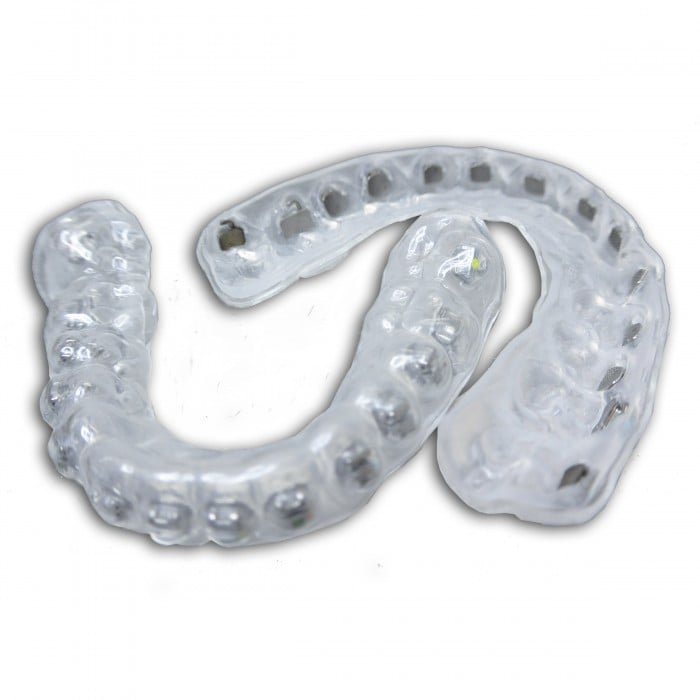smart moves® exceed® Rx
Special Notes
To view prices, please create an account. The photograph shows our standard design. We can customize many of our appliances for your patient's specific needs - please see our auxiliaries and color chart (not applicable for nylon appliances).
smart moves® exceed® is a patented suite of precision computer-aided bracket placement solutions. This exclusive technology determines the exact digital placement coordinates for each bracket. Then, through the use of cutting-edge 3D model printing technology, bonding trays are manufactured with unrivaled fit and bracket position accuracy.
exceed Provides Unprecedented Accuracy -
Powerful software scientifically calculates the ideal position of the brackets on the teeth:
- Outcomes are more predictable and consistent
- Adjustments to brackets and archwires are minimized or eliminated
- Patient satisfaction is increased
exceed Offers Two Different Methods to Calculate Ideal Bracket Positioning
- exceed Rx: Position of appliances is individualized using the pre-treatment occlusion
- exceed Tx: Position of the appliances is optimized to fit a virtual post-treatment setup
exceed is Fast and Efficient -
- exceed significantly reduces time spent placing brackets
- exceed minimizes chair time and increases patient comfort
exceed Gives You Ultimate Control -
- Prior to tray fabrication, a virtual model will be available for your review and approval. The user-friendly software will allow you to adjust the bracket placement, giving you ultimate control.
- We can use your brackets or you can select ours. exceed is compatible with most popular straight-wire bracket systems.
| GLO Exclusive | No |
|---|---|
| Turnaround Time | 9-10 Business days. Turnaround is subject to change based on timeliness of customer approvals and method of record submission. |
| Medicare Accepted | No |
| Removable | No |
| Banded | No |
| Bite Required | Centric Occlusion (CO) |
| Material Type | Splint Biocryl |
Mail Traditional Models
Step 1 - Download Prescription
Step 2 - Print a Shipping Label
Step 3 - Mail it in!
Canadian and International Customers
Ship to:
Great Lakes Dental Technologies
PO BOX 5111
Tonawanda NY 14150-5111
USA
Upload Digital Models
Option 1
Select your scanner to view easy instructions on how to submit a digital model.
Great Lakes also supports DDX, Medit, and Planmeca. If you need assistance, please contact us.
Option 2
Upload your digital models to the Great Lakes Digital Portal. It's a simple and secure way that accepts STL files from any scanner. Click here for instructions.
Chairside Bonding
General Requirements
Impressions:
- Accurate impressions with any type of impression material are acceptable
- Impressions must adequately reflect all relevant anatomy
- Impression material must not be separating from the impression tray
- Consider pouring your models right away if your impressions are moisture, temperature, or time sensitive
- Impressions sensitive to moisture content should be wrapped in a damp paper towel and placed in a sealed plastic bag if models are not poured immediately
- Only metal impression trays and those with VPS impression material will be returned
- The nature of impression materials currently on the market may contribute to common model problems encountered in the laboratory. Have you encountered porosity (bubbles, voids) or poor surface quality? Plaster or stone mixes are water based and they interact with impression surfaces in a water-like manner. Liquids placed on solid surfaces will be either attracted to, or repelled from that surface in varying degrees. Please be aware when selecting impression material if it is hydrophilic or hydrophobic.
Hydrophilic: is attracted to, or can be wetted by water.
Hydrophobic: is when liquid is repelled or fails to bond with liquids.
Vinyl poly siloxane (VPS) options can be hydrophilic or hydrophobic. Alginate is hydrophilic.
- There are advantages and disadvantages to these impression options but there are products on the market to help reduce the disadvantages. Surfactants and debubblizer sprays can be used to lower surface tension between surfaces making the impression material more hydrophilic and assure a better impression result.
- Great Lakes carries ACU-flow™ a VPS impression material which is hydrophilic and requires NO surfactant spray for surface tension reduction, eliminating bubble formation. Surfactants must be used properly and excess surfactant should not be allowed to pool in the cusp tips. This can cause loose, sandy-like cusp tips. Excess surfactant needs to be blown out leaving a wet look only before pouring.
Learn how to take a reliable impression
Models:
- Plaster or stone models are acceptable. Generally, the durability of stone is preferred.
- Models should be reasonably trimmed, yet sufficiently thick for strength considerations.
- No horseshoe-shaped models; Models should have a base of at least 7mm in the thinnest area.
- Bases will be added as necessary (for an additional fee) to models without bases or those lacking adequate base thickness or strength.
- Please indicate if your model must be duplicated as work models may get damaged during the appliance fabrication process.
Bite Records:
- Please package bite registrations carefully.
- Bite records must not be left between models for shipment to the lab.
- Dedicated packaging should be considered for brittle materials such as Delar wax.
- Please identify the nature and the intent of each bite record, if more than one is being supplied.
- Please consider mounting the maxillary model, before sending it to the lab, for those cases requiring mounting. Sending items such as facebows, bite forks, and mounting jigs through the mail often results in unreliable mountings.
Articulators:
We use the following articulators and their accessories in our laboratory:
- SAM® 1, SAM® 2, SAM® 3
- Denar®
- Panadent
- Whip Mix
- Hanau™
- Stratos 200
- Artex®
- Kavo

 Download prescription forms and mailing labels. Learn how you can send your
cases to us digitally with many popular intraoral scanners.
Download prescription forms and mailing labels. Learn how you can send your
cases to us digitally with many popular intraoral scanners.
